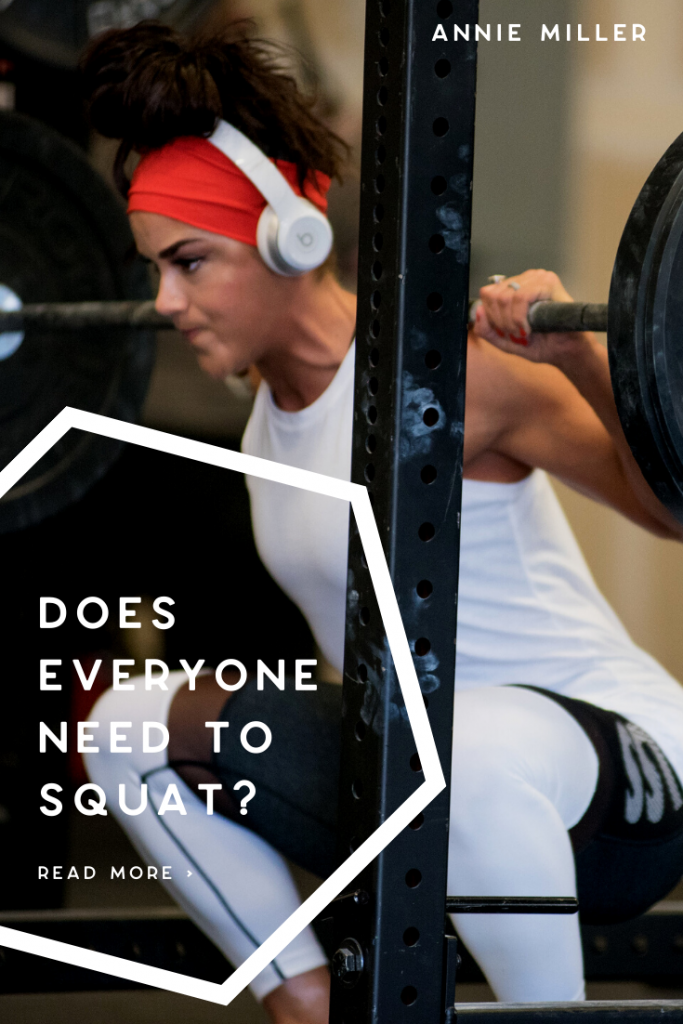the blog
welcome to
looking for something specific? find it here

Does everyone need to squat? In short. No.
I am one of the biggest advocates for functional movements and squat is by far my favorite one. BUT, not everyone needs to squat.
It is ideal to be able to squat. It is a natural human movement and in large portions of the world, people spend most of their day in a deep squat. Watch a baby. Baby squats make me giddy. They are perfect. So innate.
What’s more important than squatting is being able to get down to the ground and up off of the ground in a functional manner. And getting up out of a chair without help. The longevity of your life depends on these tasks and abilities.
Common reasons someone may not choose to squat:
- Back or hip injuries
- Hip or ankle mobility restrictions
- Actual anatomical limitations (anteversion of the hips, boney blockages in the hips or leg length differences)
- They don’t like them
All of the reasons listed above can be addressed and improved so that a person can squat in some fashion. They are, nonetheless, reasons a person may decide not to squat. And it’s not the end of the world.
Some things to focus on besides performing a squat.
You don’t have to do an actual squat to get the training stimulus and results as you get from squatting. There are tons of single leg exercises that represent a squat pattern.
- High box step ups
- Reverse lunge from a deficit
- Bulgarian split squat
- …most split squats
- Pistol squats (and variations)
The back squat is the mother of ALL squats but there are many squat variations and all require a slightly different movement pattern. This is because the weight is loaded differently on the body.
- Box squats
- Front squats
- Zercher squats
The above are all barbell squats. Then you have dumbbell, kettle bell and more unorthodox variations:
- Goblet squat
- Waiter squats
- Belt squats
- Landmine squats
- Cable squats
I encourage people, if they are able, to do at least one variation of the squat. In my experience there is almost always a variation that is comfortable for each person.
So let’s discuss some options if bilateral squatting is out of the question.
Enter single leg work
Why single leg?
Because typically if someone cannot squat in a bilateral pattern, they’ve got a better chance unilaterally. There is more room for adjusting the movement to be comfortable when only one femur is working with the pelvis.
You’re likely able to reach a deeper range of motion with less discomfort on one leg than two.
Think of a squatting pattern as the knee and hip angles decreasing or closing at the same rate. The knee should come forward and hips should sit down and back until the hip crease is below the top of the knee. All of which happen in the exercises previously listed:
- High box step ups
- Reverse lunge from a deficit
- Bulgarian split squat
- …most split squats for that matter
- Pistol squats (to a low box, off a box, cable, pole or TRX assisted)
In any of the above, the more positive shin angle you can get with a flat foot and solid mechanics, the more “squat” like it becomes. The more vertical the shin becomes, the more the glutes and hamstrings come into play, eliciting more of a deadlift/hinge pattern.
Not everyone needs to squat.
Everyone should if they can in my professional opinion. There are a lot of variations to rule out before someone says no to squatting. But there are also plenty of ways to get strong and move well without squatting.
If you’re into NOT squatting, check out Mike Boyle. He thinks no one should squat because you’re less likely to get injured and can get crazy strong via single leg work compared to bilateral squatting. Which is all true. You can read several blogs by Mike explaining why they don’t squat, here’s one of them.
We all get to have our training philosophies. Hopefully this blog helped you shape or better understand your own.
Are you into squatting? Want a progressive, functional program that will inspire you to learn as you train without asking you to figure it all out for yourself? Click here to see if Built By Annie is the right fit for you (three options available).
Join my mailing list for weekly blog and podcast updates. You may or may not get VIP discounts as well. Just saying. Join the fam.
I'm an adventurous introvert from Vancouver, Washington who lives on sleep + "me time." I'm a lover of lifting weights, dinosaurs, real talk and traveling with my husband. I am here to help you move better, lift more, bust the myths of the fitness industry, and inspire you to love the process.
Hey you,
The name's Annie & you're reading my thoughts. Let's get acquainted.
the whole story >
looking for something specific? find it here
THE LINKS BELOW ARE AFFILIATE LINKS
SKIN CARE
Nutrition
brands I love
working against gravity
Fre skin care
favorites
blue light blockers
klassy network
code: fdba saves you 15% off
online TRAINERS
save $50
code: ANNIE saves you 20% off
You love my style, trust my reviews, and want more Annie Miller Concepts vibes in your life? Shop my favorite brands. You get awesome products and yours truly gets a little kick-back.
